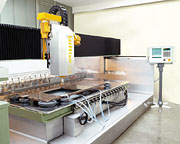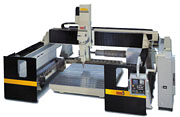
Many companies have adopted a widespread use of computers in an attempt to rid the workplace of human error and make stone cutting a more exact process. For companies that produce large numbers of identical products, this accuracy is important.
CNC systems have also added to the increasing complexity of stone fabrication. These machines have played a significant role in the advancement of stone design.
One such machine is the Omag Mill 5. Combining high technology with simplicity, the Mill 5 is a numerically controlled machine with 5 to 12 axes that is capable of forming, routing, engraving, milling, sculpting, sawing, polishing and lathe work on marble, granite and all types of stone. The Mill 5 is a high-output machine both for online production and for single, one-off pieces. The axes are driven by brushless motors combined with ball bearing screws. Linear guides with ball runners assure lasting quality and precision. All parts are protected by PVC bellows and lubricated with oil by a controlled centralized system. Omag machines are distributed in the U.S. by Bergman-Blair Machine Corp.
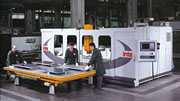
StonExpo 2001 will mark the official unveiling of the N-138-S computer numerically controlled (CNC) machining center built by Northwood Machine Manufacturing and distributed by VIC International. The N-138-S was designed and built in the U.S. specifically for the stone industry. Standard features include a 20-hp (15kW) variable speed (0-15000 rpm) spindle motor, 13- x 8-foot work envelope, and a 28-position tool changer. The N-138-S standard CAD/CAM package allows for easy programming, and the movable gantry design simplifies loading and unloading.
Intermac recently introduced a new machine called the Jet, available through AGM. The Jet is offered at a competitive price without sacrificing the quality and reputation Intermac is famous for, according to the company. The machine utilizes a gantry structure, which allows for convenient loading and unloading. The unique spindle design permits continuous production, and the machine can be continuously loaded, since operators can place the next piece while the machine is working, eliminating downtime and increasing productivity. The Jet has a usable bed of 59 x 118 inches and 22 tool positions, allowing the greatest flexibility for machining centers of this type, according to the company. With an optional fourth axis, bowl holes and shaped lamination strips can be cut simply and affordably. All Intermac machines come equipped with state-of-the-art Allen Bradley/OSAI Series 10 controls, which are known for their reliability. The Jet offers many distinct advantages such as on-the-fly tool wear compensation and a self contained robust structure. The Intermac Jet has a user-friendly CAD/CAM system, which allows operators with limited experience to be trained in a short time.
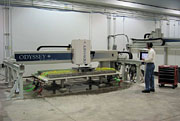






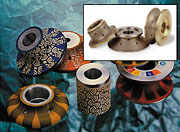
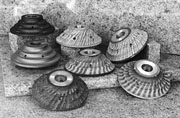


Accessories
Braxton-Bragg carries a complete line of Diamond CNC tooling by Ghines of Italy. Ghines has created a CNC tooling system that will profile and polish marble, granite, agglomerate and other engineered stone with excep-tional results, according to the company. The six-step CNC process includes three metal-bonded wheels for profiling and three polishing wheels. The company claims this six-step system will out perform the traditional seven-step process while saving time and money.